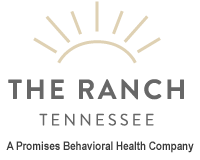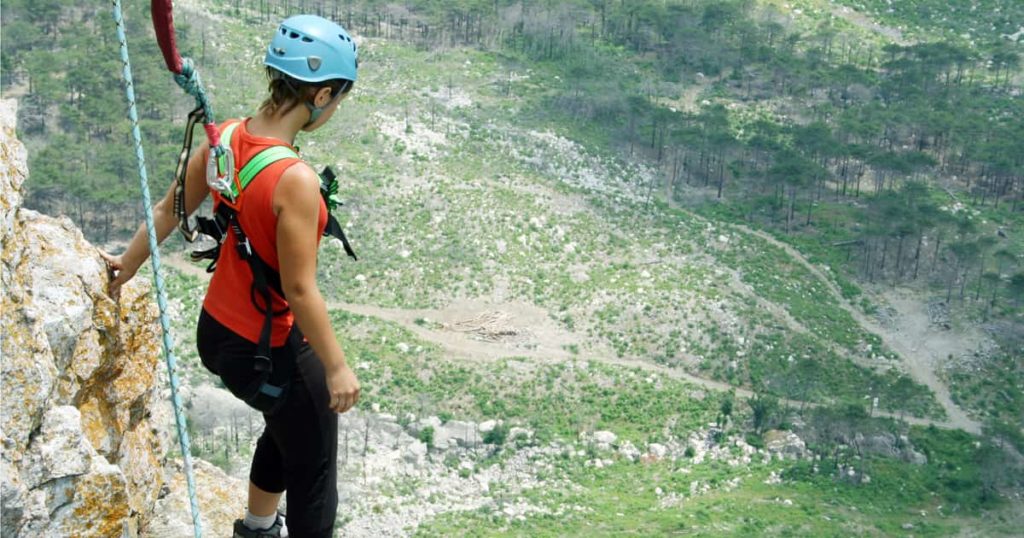By Megan Repass, MS, LADAC-II, CCM, EAGALA-C, Director of Adventure and Equine Therapy at The Ranch Laurel nervously climbed the tall pole. Once she made it to the top she tried to balance her weight on the small platform. Her ultimate destination was back down ― but the ground was 80 feet below and jumping was her only route. Her heart was beating fast as she prepared herself for the “Leap of Faith,” a high ropes experience in the Adventure Therapy Program at The Ranch. Even though she was safely harnessed and attached to a belay rope, Laurel felt like it was a huge risk. That’s what made this experiential therapy so powerful. Her task was to jump off the pole into literally nothing while trusting her “sisters” below. Panic set in. Then she heard the cheers of her teammates below, calling out her name and yelling, “Good job!” and “You’ve got this.” She looked down to see them waving and encouraging her to do something she’d been afraid to try her entire life — take a risk. She’d spent her teen years and 20s afraid to disobey her strict mother and abusive father. She drank and secretly self-harmed to forget about the pain. Now she had a choice: Stand in her fear or jump and fly free. She jumped. Suddenly, Laurel was freefalling. The intensity of the fall quickly turned into a moment of hanging in midair, the ropes being securely managed by facilitators below. In that moment, as she floated, Laurel realized that she was safe. “Woo-hoo, I can fly,” she cried out as she was slowly lowered to the ground. She hummed the theme music to “Superman.” She later said it was one of the most freeing things she’d ever done. “I felt more courageous when I reached the ground,” she said.
Lessons From the High Ropes
Jumping into the unknown can be terrifying under any circumstances. Recovery is like a leap into the unknown because you must leave old behaviors behind and develop new coping skills. High ropes adventure therapy helps develop confidence. And the high ropes teach important life lessons.
- Taking risk equals reward. Risk-taking can be anything that gets you out of your comfort zone. It may be a small step or a big jump. The Ranch utilizes a myriad of rope activities — both high and low — to encourage you to take initiative, solve problems, and team-build while boosting It allows you to be scared and brave at the same time. A grand gesture, like jumping off a platform at 60 feet, can make you feel as if you have achieved the impossible. This is a lesson that can be applied to the hard road of recovery. While it may sometimes seem impossible, millions of people have succeeded and you can, too.
- Getting beyond your comfort zone. Some people have an irrationally small comfort zone. For example, something may have happened in childhood that made you so terrified of heights that you can’t face walking up even a small set of stairs. Or perhaps you are afraid to speak up for yourself around certain people. High ropes challenge you to step beyond your comfort zone ― and the place you are stuck in life ― and realize that you are safe and you can survive it. Eventually your comfort zone will expand. High ropes may not be right for everyone, so activities closer to the ground ― such as low ropes or simply standing next to a horse ― can be a place to start. Every step toward making your comfort zone larger is an accomplishment.
- Trusting in yourself and others. High ropes challenge you to practice trust. You may start out saying, I don’t trust anyone or I definitely don’t trust myself because I’ve relapsed before. To recover, you must learn to trust again. Sometimes it begins by trusting in the environment, the facilitators, and the people you are partnered with. Sometimes other people model behaviors that can teach you more about how to be trustworthy and how to become more adept at self-trust.
- Surrender doesn’t mean weakness. Many people struggle with letting go. Essentially, you are dealing with rope, a system of cables, the facilitators and your belay partner. When you climb up that pole, it feels as if you are putting your life into someone else’s hands. Surrender is needed in order to accomplish the task. Once you get up, you cannot climb back down so you must rely on those around you. But it also means surrendering to a power greater than yourself.
- Overcoming fear. When you first get harnessed to the belay rope, your heart may beat faster and your body may shake from nerves. Then, suddenly, you are climbing a pole. And then you are standing on top of it. It seemed impossible, but you’re there! The fear that could keep you on the ground because you are so terrified is the same fear that keeps you stuck in life. It’s the same fear that keeps you in the abusive relationship you can’t leave. It’s the same fear that keeps you going back to the bottle. Fear is fear. Fear can alert you to danger, but it can also become irrational and hold you hostage. One of the ultimate breakthroughs of the high ropes is to move beyond fear.
- Becoming more courageous. You’re not a bird and not meant to fly, so in many ways it’s a good thing that you have concerns about jumping off high structures. But in a safe, supervised environment, taking on a challenge you never thought you could, makes you braver. Any time you take even the smallest step in the direction of courage, it will make you stronger.
You may compare this to being a first-time skier who takes the lift up the mountain and skis down. It may seem like no big deal because everyone skis. But to you it’s new, and scary, and when you get to the bottom of the slope, you feel proud of your accomplishment. The same is true with high ropes. When you get to the ground, there is a palpable sense of success. I did it even though I didn’t think or feel like I could.

